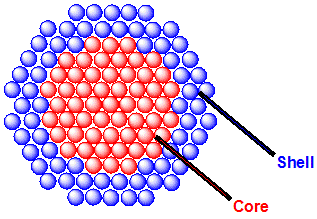Core-Shell Nanoparticles: Harnessing the Synergy of Hybrid Nanomaterials
Introduction to Core-Shell Nanoparticles
Core-shell nanoparticles are a captivating class of nanostructured materials that have garnered significant attention from researchers across various fields. These ingeniously designed nanoparticles consist of a core made of one material, which is encapsulated by a shell composed of a different material. By carefully selecting the core and shell materials and precisely controlling their dimensions, scientists can fine-tune the properties of core-shell nanoparticles to suit a wide range of applications, from biomedical diagnostics and targeted drug delivery to catalysis and optoelectronics.

Designing Core-Shell Nanoparticles
The beauty of core-shell nanoparticles lies in the vast possibilities for material combinations and architectures. The core and shell can be composed of various materials, including metals, metal oxides, semiconductors, and polymers. By judiciously selecting the core and shell materials, researchers can create nanoparticles with unique properties that are not attainable with single-component nanoparticles.
Inorganic Core-Inorganic Shell Nanoparticles
Inorganic core-inorganic shell nanoparticles have an inorganic core surrounded by an inorganic shell of a different material. These nanoparticles offer a plethora of possibilities for tailoring optical, magnetic, and catalytic properties. For example, gold-silica core-shell nanoparticles have been extensively studied for their unique optical properties and biocompatibility, making them attractive for bioimaging and photothermal therapy applications.
Inorganic Core-Organic Shell Nanoparticles
Inorganic core-organic shell nanoparticles consist of an inorganic core encapsulated by an organic shell, such as a polymer or a biomolecule. The organic shell can provide stability, biocompatibility, and functionality to the nanoparticle. These hybrid nanostructures have found applications in drug delivery, where the inorganic core can carry therapeutic agents, while the organic shell ensures targeted delivery and controlled release.
Organic Core-Inorganic Shell Nanoparticles
Organic core-inorganic shell nanoparticles have an organic core, such as a polymer or a lipid, surrounded by an inorganic shell. The inorganic shell can impart enhanced mechanical and thermal stability to the nanoparticle. These nanostructures have been explored for applications in catalysis and sensing, where the organic core provides a high surface area, while the inorganic shell offers stability and selectivity.
Synthesis Strategies for Core-Shell Nanoparticles
The synthesis of core-shell nanoparticles requires precise control over the reaction conditions to ensure the formation of well-defined nanostructures. Several methods have been developed for the synthesis of core-shell nanoparticles, each with its own advantages and challenges.
Seed-Mediated Growth
Seed-mediated growth is a popular method for synthesizing core-shell nanoparticles. In this approach, pre-synthesized core nanoparticles (seeds) serve as templates for the growth of the shell material. The shell material is often deposited onto the core through chemical reduction, precipitation, or sol-gel processes. This method allows for the precise control over the shell thickness and composition.
One-Pot Synthesis
One-pot synthesis involves the simultaneous formation of the core and shell materials in a single reaction vessel. By carefully controlling the reaction conditions, such as temperature, pH, and reactant concentrations, researchers can achieve the desired core-shell nanostructure. This method is advantageous for its simplicity and scalability, making it attractive for large-scale production.
Layer-by-Layer Assembly
Layer-by-layer assembly is a versatile technique for creating multi-layered core-shell nanoparticles. This approach involves the sequential deposition of oppositely charged materials onto the core nanoparticle. Polyelectrolytes, nanoparticles, and biomolecules can be assembled layer by layer to create complex core-shell architectures with precise control over the shell thickness and composition.
Applications of Core-Shell Nanoparticles
Core-shell nanoparticles have found applications in various fields, leveraging their unique properties arising from the synergistic combination of the core and shell materials.
Biomedical Applications
Core-shell nanoparticles have revolutionized the field of biomedicine, offering new possibilities for diagnostic imaging, targeted drug delivery, and therapy. For example, gold-silica core-shell nanoparticles have been used for photothermal therapy and drug delivery, while magnetic-polymer core-shell nanoparticles have been employed for targeted drug delivery and magnetic resonance imaging (MRI).
Catalysis
Core-shell nanoparticles have emerged as promising catalysts for various chemical reactions. The core material can provide high surface area and catalytic activity, while the shell can enhance the stability and selectivity of the catalyst. Platinum-palladium core-shell nanoparticles have shown excellent catalytic performance in fuel cell applications, while cerium oxide-zirconium oxide core-shell nanoparticles have been used for automotive exhaust catalysis.
Optoelectronics and Sensors
The unique optical and electronic properties of core-shell nanoparticles make them attractive for optoelectronic and sensing applications. Core-shell quantum dots, such as CdSe-ZnS, have been widely used in light-emitting diodes (LEDs), solar cells, and fluorescent sensors due to their tunable emission and high quantum yields. Additionally, metal-semiconductor core-shell nanoparticles, such as gold-titanium dioxide, have been employed for photocatalysis and surface-enhanced Raman scattering (SERS) sensing.
Challenges and Future Perspectives
While core-shell nanoparticles have shown immense potential in various applications, several challenges need to be addressed for their widespread implementation. Precise control over the size, shape, and composition of the core and shell materials is crucial for achieving the desired properties and performances. Additionally, the long-term stability and potential toxicity of core-shell nanoparticles in biological systems require thorough investigation.
Future research in core-shell nanoparticle development will focus on the design of multi-functional nanostructures with enhanced properties and targeted functionalities. The integration of core-shell nanoparticles with other nanomaterials, such as graphene and metal-organic frameworks (MOFs), will enable the creation of advanced nanocomposites for energy storage, catalysis, and sensing applications. Furthermore, the exploration of core-shell nanoparticles for in vivo biomedical applications, such as theranostics and regenerative medicine, will be a key area of investigation.
Further Reading
Chemical Society Reviews, Core–shell nanoparticles: synthesis and applications in catalysis and electrocatalysis
Chemical Reviews, Core/Shell Nanoparticles: Classes, Properties, Synthesis Mechanisms, Characterization, and Applications
International Journal of Engineering, Science and Technology, A comprehensive study of synthesis and applications of core/shell nanoparticles
